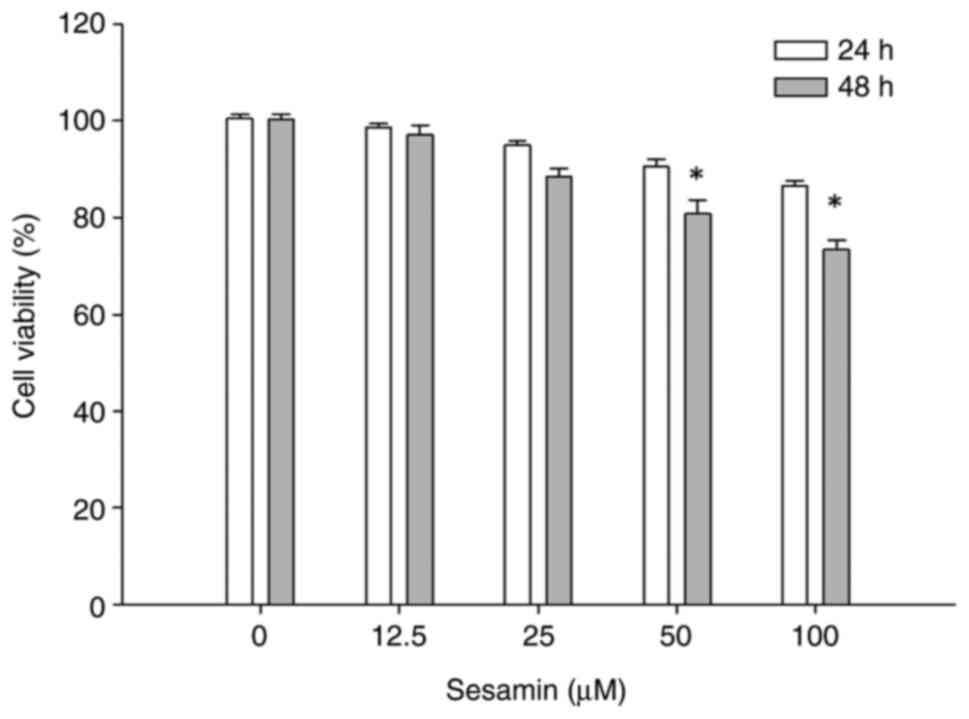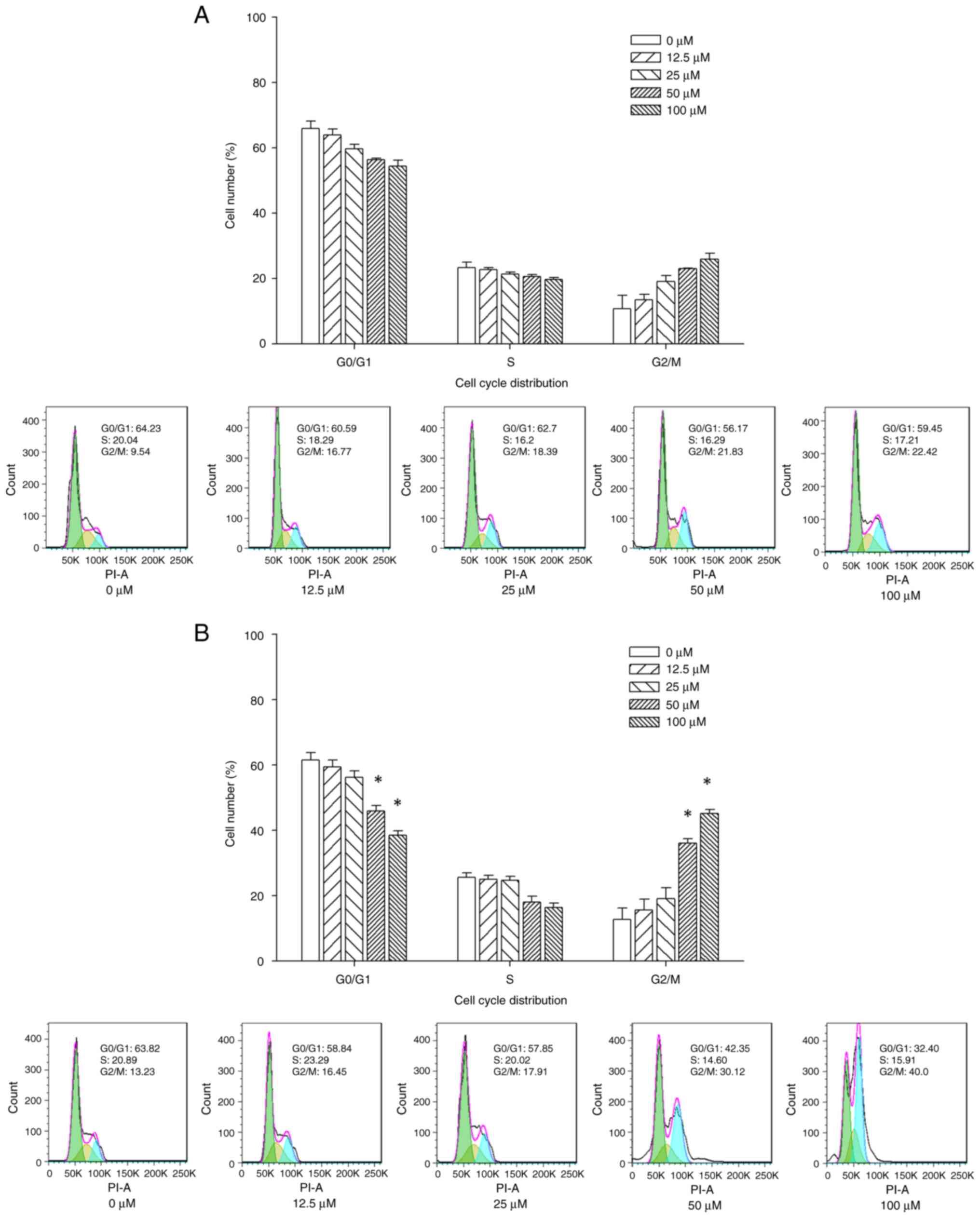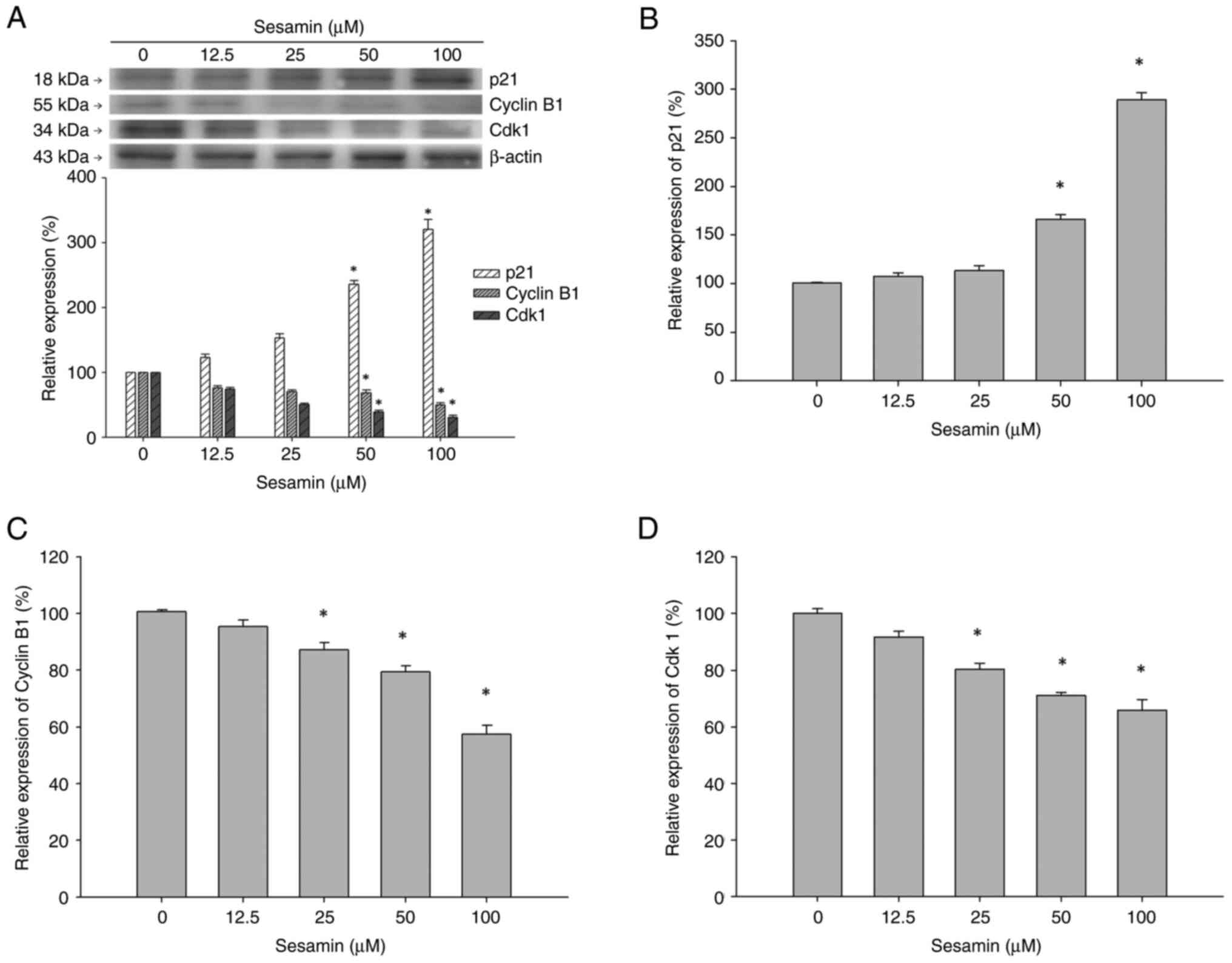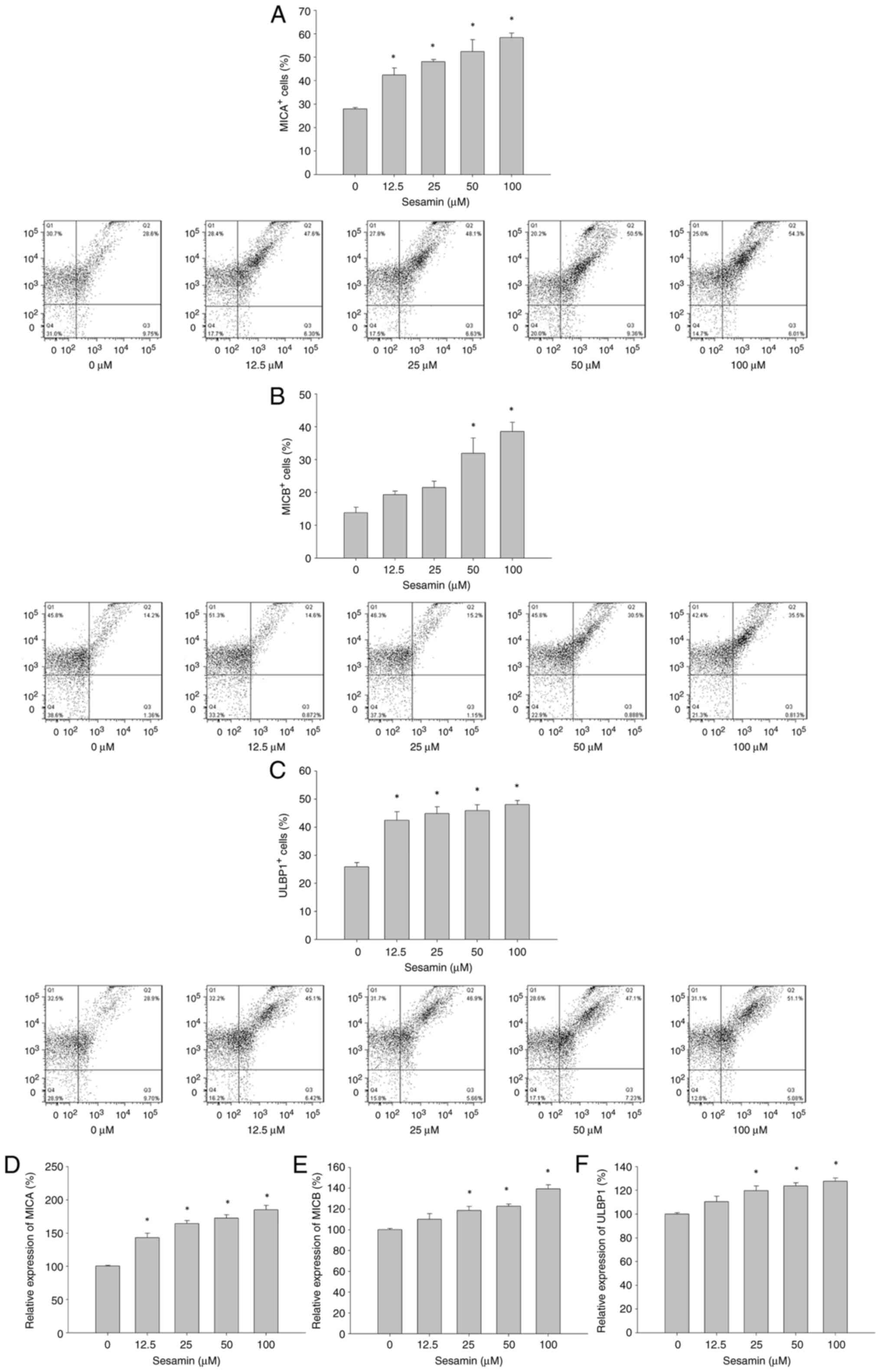|
1
|
Ottaviani G and Jaffe N: The epidemiology
of osteosarcoma. Cancer Treat Res. 152:3–13. 2009.PubMed/NCBI View Article : Google Scholar
|
|
2
|
Li W and Zhang S: Survival of patients
with primary osteosarcoma and lung metastases. J BUON.
23:1500–1504. 2018.PubMed/NCBI
|
|
3
|
Kager L, Zoubek A, Pötschger U, Kastner U,
Flege S, Kempf-Bielack B, Branscheid D, Kotz R, Salzer-Kuntschik M,
Winkelmann W, et al: Primary metastatic osteosarcoma: Presentation
and outcome of patients treated on neoadjuvant cooperative
osteosarcoma study group protocols. J Clin Oncol. 21:2011–2018.
2003.PubMed/NCBI View Article : Google Scholar
|
|
4
|
Gomez-Brouchet A, Illac C, Gilhodes J,
Bouvier C, Aubert S, Guinebretiere JM, Marie B, Larousserie F,
Entz-Werlé N, de Pinieux G, et al: CD163-positive tumor-associated
macrophages and CD8-positive cytotoxic lymphocytes are powerful
diagnostic markers for the therapeutic stratification of
osteosarcoma patients: An immunohistochemical analysis of the
biopsies fromthe French OS2006 phase 3 trial. Oncoimmunology.
6(e1331193)2017.PubMed/NCBI View Article : Google Scholar
|
|
5
|
Eller MA and Currier JR: OMIP-007:
Phenotypic analysis of human natural killer cells. Cytometry A.
81:447–449. 2012.PubMed/NCBI View Article : Google Scholar
|
|
6
|
Lanier LL: NK cell recognition. Annu Rev
Immunol. 23:225–274. 2005.
|
|
7
|
Lanier LL: NKG2D receptor and its ligands
in host defense. Cancer Immunol Res. 3:575–582. 2015.PubMed/NCBI View Article : Google Scholar
|
|
8
|
Mistry AR and O'Callaghan CA: Regulation
of ligands for the activating receptor NKG2D. Immunology.
121:439–447. 2007.PubMed/NCBI View Article : Google Scholar
|
|
9
|
Raulet DH, Gasser S, Gowen BG, Deng W and
Jung H: Regulation of ligands for the NKG2D activating receptor.
Annu Rev Immunol. 31:413–441. 2013.PubMed/NCBI View Article : Google Scholar
|
|
10
|
Le Bert N and Gasser S: Advances in NKG2D
ligand recognition and responses by NK cells. Immunol Cell Biol.
92:230–236. 2014.PubMed/NCBI View Article : Google Scholar
|
|
11
|
Wu MS, Aquino LBB, Barbaza MYU, Hsieh CL,
Castro-Cruz KA, Yang LL and Tsai PW: Anti-Inflammatory and
anticancer properties of bioactive compounds from Sesamum indicum
L.-A review. Molecules. 24(4426)2019.PubMed/NCBI View Article : Google Scholar
|
|
12
|
Wang X, Qiao J, Zou C, Zhao Y and Huang Y:
Sesamin induces cell cycle arrest and apoptosis through p38/C-Jun
N-terminal kinase mitogen-activated protein kinase pathways in
human colorectal cancer cells. Anticancer Drugs. 32:248–256.
2021.PubMed/NCBI View Article : Google Scholar
|
|
13
|
Siao AC, Hou CW, Kao YH and Jeng KC:
Effect of sesamin on apoptosis and cell cycle arrest in human
breast cancer mcf-7 cells. Asian Pac J Cancer Prev. 16:3779–3783.
2015.PubMed/NCBI View Article : Google Scholar
|
|
14
|
Deng P, Wang C, Chen L, Wang C, Du Y, Yan
X, Chen M, Yang G and He G: Sesamin induces cell cycle arrest and
apoptosis through the inhibition of signal transducer and activator
of transcription 3 signalling in human hepatocellular carcinoma
cell line HepG2. Biol Pharm Bull. 36:1540–1548. 2013.PubMed/NCBI View Article : Google Scholar
|
|
15
|
Yokota T, Matsuzaki Y, Koyama M, Hitomi T,
Kawanaka M, Enoki-Konishi M, Okuyama Y, Takayasu J, Nishino H,
Nishikawa A, et al: Sesamin, a lignan of sesame, down-regulates
cyclin D1 protein expression in human tumor cells. Cancer Sci.
98:1447–1453. 2007.PubMed/NCBI View Article : Google Scholar
|
|
16
|
Akl MR, Ayoub NM, Abuasal BS, Kaddoumi A
and Sylvester PW: Sesamin synergistically potentiates the
anticancer effects of γ-tocotrienol in mammary cancer cell lines.
Fitoterapia. 84:347–359. 2013.PubMed/NCBI View Article : Google Scholar
|
|
17
|
Akl MR, Ayoub NM and Sylvester PW:
Mechanisms mediating the synergistic anticancer effects of combined
γ-tocotrienol and sesamin treatment. Planta Med. 78:1731–1739.
2012.PubMed/NCBI View Article : Google Scholar
|
|
18
|
Livak KJ and Schmittgen TD: Analysis of
relative gene expression data using real-time quantitative PCR and
the 2(-Delta Delta C(T)) method. Methods. 25:402–408.
2001.PubMed/NCBI View Article : Google Scholar
|
|
19
|
Tobeiha M, Rajabi A, Raisi A, Mohajeri M,
Yazdi SM, Davoodvandi A, Aslanbeigi F, Vaziri M, Hamblin MR and
Mirzaei H: Potential of natural products in osteosarcoma treatment:
Focus on molecular mechanisms. Biomed Pharmacother.
144(112257)2021.PubMed/NCBI View Article : Google Scholar
|
|
20
|
Majdalawieh AF, Massri M and Nasrallah GK:
A comprehensive review on the anti-cancer properties and mechanisms
of action of sesamin, a lignan in sesame seeds (Sesamum indicum).
Eur J Pharmacol. 815:512–521. 2017.PubMed/NCBI View Article : Google Scholar
|
|
21
|
Chen Y, Li H, Zhang W, Qi W, Lu C, Huang
H, Yang Z, Liu B and Zhang L: Sesamin suppresses NSCLC cell
proliferation and induces apoptosis via Akt/p53 pathway. Toxicol
Appl Pharmacol. 387(114848)2020.PubMed/NCBI View Article : Google Scholar
|
|
22
|
Karimian A, Ahmadi Y and Yousefi B:
Multiple functions of p21 in cell cycle, apoptosis and
transcriptional regulation after DNA damage. DNA Repair (Amst).
42:63–71. 2016.PubMed/NCBI View Article : Google Scholar
|
|
23
|
Pawlik TM and Keyomarsi K: Role of cell
cycle in mediating sensitivity to radiotherapy. Int J Radiat Oncol
Biol Phys. 59:928–942. 2004.PubMed/NCBI View Article : Google Scholar
|
|
24
|
Winters ZE: P53 pathways involving G2
checkpoint regulators and the role of their subcellular
localisation. J R Coll Surg Edinb. 47:591–598. 2002.PubMed/NCBI
|
|
25
|
Vogelstein B, Lane D and Levine AJ:
Surfing the p53 network. Nature. 408:307–310. 2000.PubMed/NCBI View
Article : Google Scholar
|
|
26
|
Yuan L, Zhang Y, Xia J, Liu B, Zhang Q,
Liu J, Luo L, Peng Z, Song Z and Zhu R: Resveratrol induces cell
cycle arrest via a p53-independent pathway in A549 cells. Mol Med
Rep. 11:2459–2464. 2015.PubMed/NCBI View Article : Google Scholar
|
|
27
|
Shin DY, Sung Kang H, Kim GY, Kim WJ, Yoo
YH and Choi YH: Decitabine, a DNA methyltransferases inhibitor,
induces cell cycle arrest at G2/M phase through p53-independent
pathway in human cancer cells. Biomed Pharmacother. 67:305–311.
2013.PubMed/NCBI View Article : Google Scholar
|
|
28
|
Bunz F, Dutriaux A, Lengauer C, Waldman T,
Zhou S, Brown JP, Sedivy JM, Kinzler KW and Vogelstein B:
Requirement for p53 and p21 to sustain G2 arrest after DNA damage.
Science. 282:1497–1501. 1998.PubMed/NCBI View Article : Google Scholar
|
|
29
|
Porter LA and Donoghue DJ: Cyclin B1 and
CDK1: Nuclear localization and upstream regulators. Prog Cell Cycle
Res. 5:335–347. 2003.PubMed/NCBI
|
|
30
|
Bartkova J, Horejsi Z, Koed K, Krämer A,
Tort F, Zieger K, Guldberg P, Sehested M, Nesland JM, Lukas C, et
al: DNA damage response as a candidate anti-cancer barrier in early
human tumorigenesis. Nature. 434:864–870. 2005.PubMed/NCBI View Article : Google Scholar
|
|
31
|
Gasser S, Orsulic S, Brown EJ and Raulet
DH: The DNA damage pathway regulates innate immune system ligands
of the NKG2D receptor. Nature. 436:1186–1190. 2005.PubMed/NCBI View Article : Google Scholar
|
|
32
|
Boissel N, Rea D, Tieng V, Dulphy N, Brun
M, Cayuela JM, Rousselot P, Tamouza R, Le Bouteiller P, Mahon FX,
et al: BCR/ABL oncogene directly controls MHC class I chain-related
molecule A expression in chronic myelogenous leukemia. J Immunol.
176:5108–5116. 2006.PubMed/NCBI View Article : Google Scholar
|
|
33
|
Soriani A, Zingoni A, Cerboni C, Iannitto
ML, Ricciardi MR, Di Gialleonardo V, Cippitelli M, Fionda C,
Petrucci MT, Guarini A, et al: ATM-ATR-dependent up-regulation of
DNAM-1 and NKG2D ligands on multiple myeloma cells by therapeutic
agents results in enhanced NK-cell susceptibility and is associated
with a senescent phenotype. Blood. 113:3503–3511. 2009.PubMed/NCBI View Article : Google Scholar
|
|
34
|
Morelli MB, Amantini C, Santoni M, Soriani
A, Nabissi M, Cardinali C, Santoni A and Santoni G: Axitinib
induces DNA damage response leading to senescence, mitotic
catastrophe, and increased NK cell recognition in human renal
carcinoma cells. Oncotarget. 6:36245–36259. 2015.PubMed/NCBI View Article : Google Scholar
|
|
35
|
Cerboni C, Fionda C, Soriani A, Zingoni A,
Doria M, Cippitelli M and Santoni A: The DNA damage response: a
common pathway in the regulation of NKG2D and DNAM-1 ligand
expression in normal, infected, and cancer cells. Front Immunol.
4(508)2014.PubMed/NCBI View Article : Google Scholar
|
|
36
|
Reinhardt HC, Aslanian AS, Lees JA and
Yaffe MB: p53-deficient cells rely on ATM- and ATR-mediated
checkpoint signaling through the p38MAPK/MK2 pathway for survival
after DNA damage. Cancer Cell. 11:175–189. 2007.PubMed/NCBI View Article : Google Scholar
|
|
37
|
Fuertes MB, Domaica CI and Zwirner NW:
Leveraging NKG2D ligands in immuno-oncology. Front Immunol.
12(713158)2021.PubMed/NCBI View Article : Google Scholar
|
|
38
|
Liu H, Wang S, Xin J, Wang J, Yao C and
Zhang Z: Role of NKG2D and its ligands in cancer immunotherapy. Am
J Cancer Res. 9:2064–2078. 2019.PubMed/NCBI
|
|
39
|
Schmiedel D and Mandelboim O: NKG2D
ligands-critical targets for cancer immune escape and therapy.
Front Immunol. 9(2040)2018.PubMed/NCBI View Article : Google Scholar
|
|
40
|
Weiss T, Schneider H, Silginer M, Steinle
A, Pruschy M, Polić B, Weller M and Roth P: NKG2D-dependent
antitumor effects of chemotherapy and radiotherapy against
glioblastoma. Clin Cancer Res. 24:882–895. 2018.PubMed/NCBI View Article : Google Scholar
|
|
41
|
Kim JY, Son YO, Park SW, Bae JH, Chung JS,
Kim HH, Chung BS, Kim SH and Kang CD: Increase of NKG2D ligands and
sensitivity to NK cell-mediated cytotoxicity of tumor cells by heat
shock and ionizing radiation. Exp Mol Med. 38:474–484.
2006.PubMed/NCBI View Article : Google Scholar
|
|
42
|
Sun Y, Ren J, Zhu S, Zhang Z, Guo Z, An J,
Yin B and Ma Y: The effects of sesamin supplementation on obesity,
blood pressure, and lipid profile: A systematic review and
meta-analysis of randomized controlled trials. Front Endocrinol
(Lausanne). 13(842152)2022.PubMed/NCBI View Article : Google Scholar
|
|
43
|
Tomimori N, Tanaka Y, Kitagawa Y, Fujii W,
Sakakibara Y and Shibata H: Pharmacokinetics and safety of the
sesame lignans, sesamin and episesamin, in healthy subjects.
Biopharm Drug Dispos. 34:462–473. 2013.PubMed/NCBI View Article : Google Scholar
|















